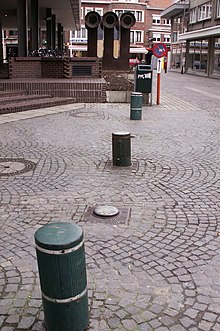This post is the last of a five part article dealing with
types of bollards and their ideal uses. This
post will discuss bollard use in industrial manufacturing plants as well as
warehouses.
Pedestrian Protection
No matter the work setting, anywhere that moving vehicles
have the potential to injure workers and guests alike, adequate protection is
required. Simple safety training of fork
lift operators, delivery truck drivers, and plant personnel is often not enough
to ensure pedestrian safety. Accidents
with heavy vehicles are often catastrophic and require additional safeguarding
to protect people from injury. A line of
bollard or bollard fencing in high traffic area is key. It is also especially important to protect
operators and workers in areas where they may not be able to see oncoming
traffic, such as when performing work related tasks. Break areas are another important area to
consider as workers are often inattentive while on break.
Many businesses choose to use surface mounted steel plate
bollards in these applications, as the speeds of vehicles is often low and this
is adequate to stop incidental contact with forbidden areas. Cored or embedded bollards can leave a
factory owner with a Swiss cheese plant floor, especially given the flexibility
required of the modern factory. But
because welded plate surface mounted bollards can quickly come loose and fall
into disrepair, rebounding type bollards
are recommended for their ability to absorb impact and avoid damage and lost
truck loads. These can also be used to
assist in proper positioning, as it is acceptable to use them as a positive
stop without a jarring impact of a traditional bollard.
Loading Docks and
Doors
It’s no secret that warehouse loading dock areas take a
beating. Delivery trucks are very large
and very heavy, and maneuvering them can be difficult even for the most experienced
driver. In order to protect building
walls, loading ramps, and high bay doors, savvy warehouse managers install
strong bollards to protect their facilities from damage due to repeated low
speed impacts from heavy vehicles.
Related to this is the interior plant doorway made for
vehicle traffic. An inattentive driver
can strike the interior walls causing a potentially dangerous situation,
especially for a cinder block wall.
Bollards strategically placed in the doorway just inside the wall
opening can prevent this sort of damage and save the plant from costly repairs.
Pallet Racks
One of the most
common workplace fines issued by the Occupations Health and Safety
Administration (OSHA) is for damaged pallet racks. Pallet racks are subject to damage because of
the large frequency of use by forklifts loading and unloading product. The slightest impact can damage structural
uprights and compromise the load integrity of the rack systems. There are many devices on the market to
protect pallet rack uprights such as cushions and guards, but the most
effective is arguable a well-placed bollard.
Corners are an especially
important area to protect as forklift can clip the end of the rack cutting a
turn. These tend to be lighter bollards in
the 3”
class as speeds tend to be low.
Equipment and
Automation
Industrial equipment and automation can be quite expensive,
not to mention critical to plant operations and business revenue. It is imperative that such equipment is
protected from vehicle traffic to eliminate the possibility of completely
avoidable downtime. Safety fencing is
often used to protect personnel from entering dangerous equipment operations
areas, but bollards or bollard fencing can serve a dual purpose of prohibiting
access from both workers and vehicular traffic.
It is not uncommon to see expensive automation equipment surrounded by a
line of bollards with W-rail attached along plant aisle ways. At other times, simple bollard protection to
keep vehicles away from delicate personnel safety fencing may be adequate.
Conclusion
In these days of hyper competitive business environments, the
costs from unnecessary interruption to operations from vehicle accidents are
intolerable. Further, the safety of
employees is a major goal of most companies.
When viewed from that perspective, the installation of protective
bollards throughout industrial operations is imperative and has become
commonplace. Business owners and
operations managers should carefully consider areas of vehicle traffic, and
especially areas that can be prone to damage or injury.
This post concludes our look at ideal bollard
applications. Although not all inclusive
of the many uses of traffic bollard, we have performed a comprehensive look at
the most common installations.





















